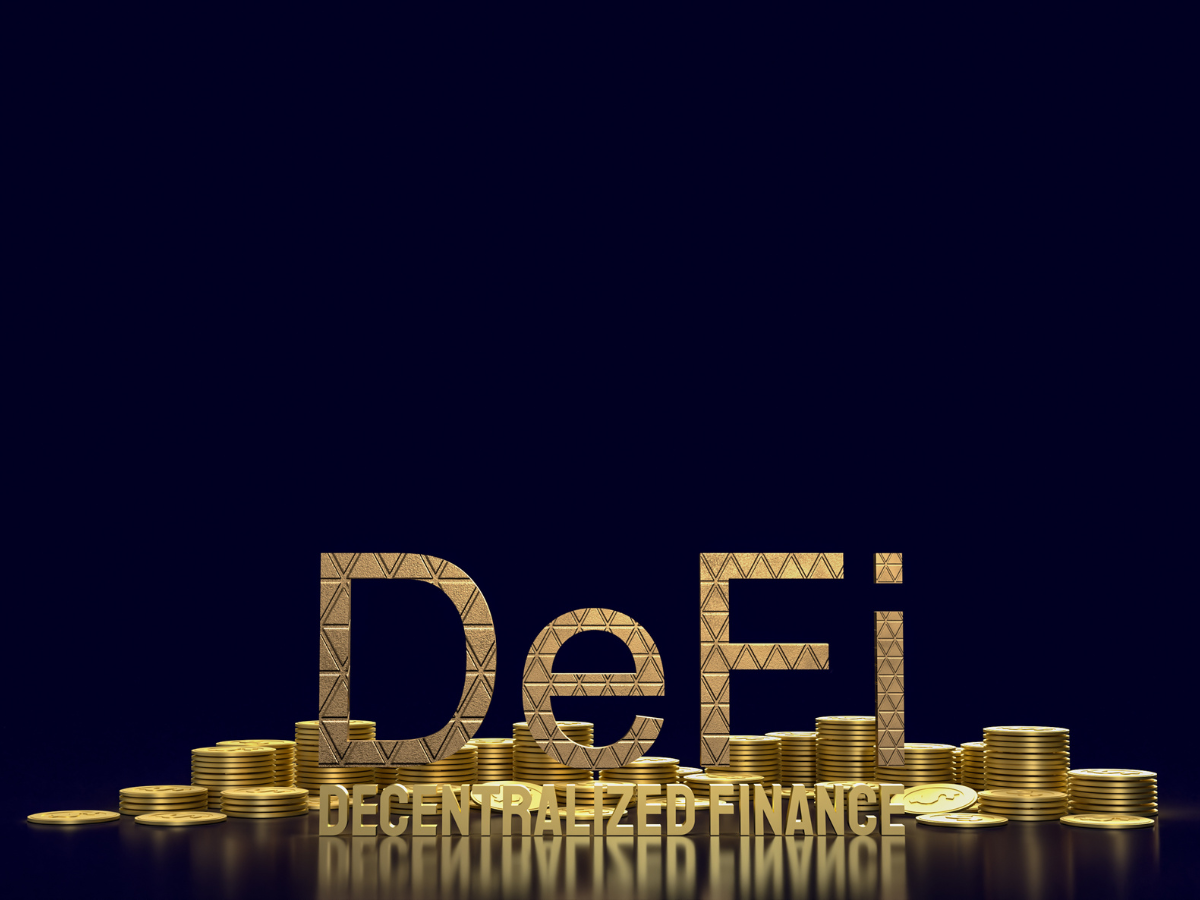Decentralized finance – aka DeFi – is an open, global alternative on the bangs of the traditional financial system.
The latter is considered restrictive, over-centralized and aging by blockchain enthusiasts who place their trust (and their money) in DeFi.
Their promise? To enable anyone with a smartphone and an Internet connection to save, trade, invest, lend or insure. The world of decentralized finance is vast. In addition, we are only at the beginning.
In this guide, find out what it is all about, what the benefits are, and how to get started with DeFi.
What is decentralized finance?
Decentralized finance is a new financial system.
It is difficult to give an exact definition, but we can summarize decentralized finance in three key points:
- It is an alternative to the traditional financial system: innovative, global and accessible to all, thanks to the internet.
- Decentralized products and services enable everyone to save, exchange financial assets, lend and borrow money.
- Decentralized finance is based on secure, public, open-source technologies: blockchains.
Why is this new way of conducting financial transactions winning over more and more users?
The main reason is that it offers a credible alternative to the monopoly of financial players.
DeFi opens the door to a more transparent, faster and less costly system, with no central authority to regulate its operation.
The control of money rests with users, not institutions or large commercial banks.
To visualize how DeFi works, we can imagine it in layers:
- The blockchain: Ethereum contains transaction history and account status (public addresses).
- Exchanged assets: ethers and other tokens acting as currencies.
- Protocols: smart contracts provide access to financial functionalities (e.g. a cryptocurrency lending service).
- Applications (DApps): the interface we use to access protocols (and therefore functionalities) and exchange crypto-assets.
How did the idea for “DeFi” come about?
No one is officially at the origin of this decentralized finance system.
However, we can discern a few major inventions that helped build it. The invention of Bitcoin in 2008, followed by Ethereum in 2014, are among them.
Bitcoin is a cryptocurrency, but it is also a payment system that can be considered the first application of decentralized finance.
Bitcoin makes it possible to own, control and transfer money from anywhere in the world.
No one needs to trust a bank or a payment application, as there is no intermediary to manage transactions.
Algorithms, computer scripts and cryptographic calculations take care of everything.
Anyone can access it and, in principle, no one can change the rules.
As for Ethereum, built on a similar idea to Bitcoin, albeit with additional functionalities.
Ethereum goes further than Bitcoin. Its programming functions, using so-called “smart contracts”, make it possible to carry out numerous financial operations similar to those found in conventional finance.
Good to know
A smart contract is simply a computer program that runs on the Ethereum blockchain. Its functions are in the code. For example, it can automatically send money.
As soon as the smart contract’s conditions are met, it executes the requested actions.
They can define rules, just like an ordinary contract, and have them applied automatically by the computer code.
They cannot be deleted from the blockchain, nor can they be modified.

What can decentralized finance do for you?
Decentralized finance offers an alternative to most existing financial services.
Developers building on the Ethereum blockchain are also testing new ways of improving current protocols, and even inventing new financial systems, every day.
We are still in the early stages.
Here are just a few of the essential financial features accessible through DeFi.
Send money anywhere, anytime
Ethereum makes it possible to transfer funds rapidly between several crypto wallets. You can send €10 or €150,000 in a matter of seconds, simply by entering the address of the destination wallet. It is as easy as sending an e-mail.
Use stable cryptocurrencies
Crypto prices often fluctuate, sometimes by quite a lot. For the time being, it is complicated to ask for a salary in ether, for example. That is why stablecoins were created to solve this volatility problem.
A stablecoin is a “stable coin”. Its value is correlated to that of a financial asset such as the dollar or the euro. A USD Coin, for example, always costs around $1. Occasionally, it will fluctuate to $0.99 or $1.01.
The USD Coin (USDC) is not a truly decentralized currency. In fact, it was created by Circle in partnership with Coinbase.
For a stablecoin to have real value, you need to ensure that this value resides somewhere (in a safe, for example). The accounting services firm Grant Thornton LLP, a group of auditors and financial experts, publishes monthly attestations on the US dollar reserves that support the price of USDC in circulation.
In March 2022, over 50 billion USDC were in circulation.
Borrow
Decentralized financial systems are changing the way borrowing is done. Neither party (lender nor borrower) needs to know each other to trust each other: the borrower must deposit collateral before borrowing. In the event of default, the counterparty automatically reimburses the lender to recover its capital. This makes it possible to borrow:
- Without a health check.
- Without being blocked by a debt ratio that is “too high”.
Save
There are several ways to earn interest on the cash you let work for you. A bit like a savings passbook, except that returns on investment (in %) are higher than traditional regulated financial products. In crypto, a return of 4% a year is standard, if not low.
Trading
There are more advanced options for traders. Limit orders, margin trading and many others are possible. Decentralized trading gives the globalized crypto market, it never closes and you can keep full control of your assets.
Financing a business start-up
Raising funds can be very complicated when you are just starting out.
Decentralized finance makes it possible to remedy an entrepreneur’s cash shortage when starting up a business. Fund-raising is simplified, enabling any professional to create his or her own token to divide his or her business into shares (and thus open up his or her capital) to be sold to investors.
The tokenization of assets, born with the Ethereum blockchain, has enabled projects to be financed thanks to an important mechanism to be aware of the Security Token Offering (STO). An STO involves issuing crypto tokens that are a digital representation of a company’s financial assets. They are like shares, which holders can exchange quickly and easily. This makes it simple to issue securities to finance your business project. These securities are highly secure, transferable and regulated.
How does DeFi work?
To simplify things as much as possible, we can say that DeFi enables the use of cryptocurrencies and smart contracts to benefit from financial services without intermediaries centralizing operations.
At present, virtually all actions involving the exchange of money are regulated, observed and validated by financial institutions.
For centuries, we have therefore entrusted unprecedented power to private intermediaries, who have a vested interest in ensuring that nobody knows exactly what happens to our funds once they are in “our” bank account, to which they have access.
In DeFi, smart contracts are the only intermediaries who carry out the requested actions. To a certain extent, you could say that they play the role of a bank, an insurer, a broker or a credit institution. Anyone can consult the status and conditions of these contracts in great detail. No one can modify them once the smart contract is online.
Ethereum plays a central role:
One of the major innovations in the cryptocurrency world is the development of the Ethereum blockchain created by Vitalik Buterin between 2013 and 2015.
Today, it has its own token (the ether) and its own programming language called Solidity. It is thanks to this language that smart contracts automatically execute requested actions after collecting the necessary data.
Nobody controls Ethereum. Even investors who own many ethers cannot change the rules to their advantage. The Ethereum blockchain is comparable to a shared, globalized public ledger. Every “account” and every transaction is public.
DeFi products and services communicate using Ethereum technology. They work together seamlessly. You can lend tokens on one platform, and exchange the token that guarantees your loan on another, different application.
It is a bit like using loyalty points from a petrol card to pay off a monthly instalment on your mortgage.

The risks of an unregulated market
That is the whole point of decentralized finance: not to rely on a central authority. This inevitably entails risks.
These include:
- Impermanent loss, due to the volatility of the exchange rates of the currencies used as collateral: a loan can be closed if it falls too much.
- The risk of market manipulation.
- Frauds: the creator of a project raises funds, issues a token that has no value in exchange for real currency or other cryptos, and disappears with the funds.
In the event of a problem, the investor has no one to turn to with a complaint. Truly decentralized platforms have no after-sales service or customer support.
Another current obstacle is the general public’s lack of knowledge about blockchain technologies. A logical phenomenon, given that we are still in the early stages of adopting these exchange protocols. Smart contracts on Ethereum are coded in a computer language called Solidity. You therefore have to trust the (sometimes anonymous) developers and blockchain consultants who understand this computer language, without being able to certify yourself that the smart contracts are authentic and reliable.
Even investors who own many ethers cannot change the rules to their advantage.
The Ethereum blockchain is comparable to a shared, globalized public ledger.
Every “account” and every transaction is public.
What’s more, certain DeFi features, notably the consensus mechanism, can lead to a concentration of power in the event of misallocation.
FAQ
Which wallet should I use to access DeFi?
MetaMask is probably the most widely used crypto wallet for accessing decentralized finance.
Alternatives exist, however: Coinbase Wallet, Argent, or even Brave Wallet and Terra Station Wallet.
Can decentralized finance be regulated?
The decentralized protocols and products that exist in DeFi do not belong to a central entity by nature. They therefore cannot be controlled. On the other hand, the taxation of revenues obtained through decentralized finance or cryptocurrency trading can be regulated. Governments therefore have the power to slow down the development of this new large-scale financial system.
What is a decentralized application?
A decentralized app (D-App) is developed following the standards or protocols of blockchains such as Ethereum, Bitcoin or Cardano.
They therefore operate on a decentralized network, their code is accessible as open-source, and the data stored on a blockchain.
Read also: Navigating 2024’s prop trading regulations: A comprehensive guide

